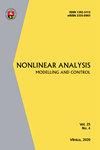Bifurcation analysis of impulsive fractional-order Beddington–DeAngelis prey–predator model
IF 2
3区 数学
Q1 MATHEMATICS, APPLIED
引用次数: 0
Abstract
In this paper, a fractional density-dependent prey–predator model has been considered. Certain reading of local and global stabilities of an equilibrium point of a system was extracted and conducted by applying fractional systems’ stability theorems along with Lyapunov functions. Meanwhile, the persistence of the aforementioned system has been discussed and claimed to imply a local asymptotic stability for the given positive equilibrium point. Moreover, the presented model was extended to a periodic impulsive model for the prey population. Such an expansion was implemented through the periodic catching of the prey species and the periodic releasing of the predator population. By studying the effect of changing some of the system’s parameters and drawing their bifurcation diagram, it was observed that different periodic solutions appear in the system. However, the effect of an impulse on the system subjects the system to various dynamic changes and makes it experience behaviors including cycles, period-doubling bifurcation, chaos and coexistence as well. Finally, by comparing the fractional system with the classic one, it has been concluded that the fractional system is more stable than its classical one.脉冲分数阶Beddington-DeAngelis捕食-捕食模型的分岔分析
本文考虑了一个分数密度依赖的捕食者-猎物模型。应用分数系统稳定性定理和李雅普诺夫函数,对系统平衡点的局部和全局稳定性进行了一定的解读。同时,讨论了上述系统的持续性,并声称对给定的正平衡点具有局部渐近稳定性。并将该模型推广为猎物种群的周期脉冲模型。这种扩张是通过定期捕获猎物物种和定期释放捕食者种群来实现的。通过研究改变系统部分参数的影响,并绘制其分岔图,观察到系统中出现了不同的周期解。然而,脉冲对系统的作用使系统发生各种动态变化,使系统经历循环、倍周期分岔、混沌和共存等行为。最后,通过将分数系统与经典系统进行比较,得出分数系统比经典系统更稳定的结论。
本文章由计算机程序翻译,如有差异,请以英文原文为准。
求助全文
约1分钟内获得全文
求助全文
来源期刊

Nonlinear Analysis-Modelling and Control
MATHEMATICS, APPLIED-MATHEMATICS, INTERDISCIPLINARY APPLICATIONS
CiteScore
3.80
自引率
10.00%
发文量
63
审稿时长
9.6 months
期刊介绍:
The scope of the journal is to provide a multidisciplinary forum for scientists, researchers and engineers involved in research and design of nonlinear processes and phenomena, including the nonlinear modelling of phenomena of the nature. The journal accepts contributions on nonlinear phenomena and processes in any field of science and technology.
The aims of the journal are: to provide a presentation of theoretical results and applications; to cover research results of multidisciplinary interest; to provide fast publishing of quality papers by extensive work of editors and referees; to provide an early access to the information by presenting the complete papers on Internet.
 求助内容:
求助内容: 应助结果提醒方式:
应助结果提醒方式:


